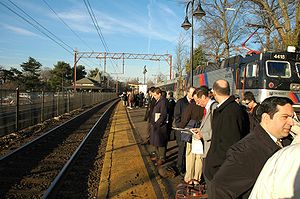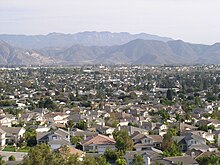Many municipalities in the US state of New Jersey can be considered commuter towns. Here, riders wait in Maplewood for a train bound for New York City during the morning rush hour.
A commuter town is a populated area that is primarily
residential, rather than commercial or industrial. People who live in
commuter towns usually work in other places. Routine travel from home to
work and then from work to home is called commuting, which is where the
term comes from.
A commuter town may be called by many other terms: "bedroom community" (Canada and northeastern US), "bedroom town", "bedroom suburb" (US), "dormitory town", "dormitory suburb", or, less commonly, "dormitory village" (Britain/Commonwealth/Ireland). In Japan, a commuter town may be referred to with the wasei-eigo coinage "bed town" (ベッドタウン, beddotaun). The term "exurb"
was also used starting in the 1950s for a commuter town, but especially
since 2006, is generally used for areas beyond suburbs and specifically
less densely built than the suburbs to which the exurbs' residents
commute.
Distinction between suburbs and commuter towns
Camarillo, California, a typical U.S. bedroom community made up almost entirely of homes, schools and retail outlets
Suburbs and commuter towns often coincide, but are not synonymous. Similar to college town, resort town and mill town, the term commuter town describes the municipality's predominant economic function. A suburb, in contrast, is a community
of lesser size, density, political power and/or commerce comparative to
a nearby community that is usually of greater economic importance. A
town's economic function may change, for example when improved transport
brings commuters to industrial suburbs or railway towns in search of suburban living. Some suburbs, for example Teterboro, New Jersey and Emeryville, California,
remained industrial when they became surrounded by commuter towns; many
commuters work in such industrial suburbs but few reside in them;
hence, they are not commuter towns.
As a general rule, suburbs are developed in areas adjacent to a main employment
center, such as a town or a city, but may or may not have many jobs
locally, whereas bedroom communities have few local businesses, and most
residents who have jobs commute to employment centers some distance
away. Commuter towns may be in rural or semi-rural areas, with a ring of
green space separating them from the larger city or town. Where urban sprawl and conurbation have erased clear lines among towns and cities in large metropolitan areas, this is not the case.
Causes
Commuter towns can arise for a number of different reasons. Sometimes, as in Sleepy Hollow, New York or Tiburon, California,
a town loses its main source of employment, leaving its residents to
seek work elsewhere. In other cases, a pleasant small town, such as Warwick, New York,
over time attracts more residents but not large businesses to employ
them, requiring denizens to commute to employment centers. Another
cause, particularly relevant in the American South and West, is the
rapid growth of small cities. The earlier creation of the Interstate Highway System
was one cause of the greatest growth was seen by the sprawling
metropolitan areas of those cities. As a result, many small cities were absorbed into the suburbs of the larger cities.
Often, however, commuter towns form when workers in a region
cannot afford to live where they work and must seek residency in another
town with a lower cost of living. The late 20th century dot-com bubble and United States housing bubble
drove housing costs in Californian metropolitan areas to historic
highs, spawning exurban growth in adjacent counties. For example, most
cities in western Riverside County, California can be considered exurbs of Orange County, California and Los Angeles County, California. As of 2003, over 80% of the workforce of Tracy, California was employed in the San Francisco Bay Area.
A related phenomenon is common in the resort towns of the American West
that require large workforces, yet emphasize building larger
single-family residences and other expensive housing. For example, the
resort town of Jackson, Wyoming has spawned several nearby bedroom communities, including Victor, Idaho, Driggs, Idaho, and Alpine, Wyoming, where the majority of the Jackson workforce resides. On Long Island, New York, many of the workforce who serve The Hamptons
also reside in communities more modest and more suburban than their
workplace, giving rise to a daily reverse commuter flow from more dense
to less dense areas.
In certain major European cities, such as Berlin and London, commuter towns were founded in response to bomb damage sustained during World War II.
Residents were relocated to semi-rural areas within a 50-mile (80 km)
radius, firstly because much inner city housing had been destroyed, and
secondly in order to stimulate development away from cities as the
industrial infrastructure shifted from rail to road. Around London,
several towns – such as Basildon, Crawley, Harlow, and Stevenage – were built for this purpose by the Commission for New Towns.
In some cases, commuter towns can result from negative economic conditions. Steubenville, Ohio, for instance, had its own regional identity along with neighboring Weirton, West Virginia until the collapse of the steel industry in the 1980s. Combined with easier access to the much larger city of Pittsburgh via the Steubenville Pike and the Parkway West,
Steubenville has shifted its marketing efforts to being a commuter town
to Pittsburgh, as well as one with a lower cost of living in Ohio compared to tax-heavy Pennsylvania. In 2013, Jefferson County, Ohio (where Steubenville is located) was added to the Pittsburgh metropolitan area as part of its larger Combined Statistical Area.
Effects
Where
commuters are wealthier and small town housing markets weaker than city
housing markets, the development of a bedroom community may raise local
housing prices and attract upscale service businesses in a process akin
to gentrification. Long-time residents may be displaced by new commuter residents due to rising house prices. This can also be influenced by zoning restrictions in urbanized areas that prevent the construction of suitably cheap housing closer to places of employment.
The number of commuter towns increased in the US and the UK during the 20th century because of a trend for people to move out of the cities into the surrounding green belt.
Historically, commuter towns were developed by railway companies to
create demand for their lines. One 1920s pioneer of this form of
development was the Metropolitan Railway (now part of London Underground) which marketed its Metro-land developments. This initiative encouraged many to move out of central and inner-city London to suburbs such as Harrow and out of London itself, to commuter villages in Buckinghamshire or Hertfordshire.
Commuter towns have more recently been built ahead of adequate
transportation infrastructure, thus spurring the development of roads
and public transportation systems. These can take the form of light rail lines extending from the city centre to new streetcar suburbs and new or expanded highways, whose construction and traffic can lead to the community becoming part of a larger conurbation.
In the United States, it is common for commuter towns to create
disparities in municipal tax rates. When a commuter town collects few
business taxes, residents must pay the brunt of the public operating
budget in higher property or income taxes. Such municipalities may scramble to encourage commercial growth once an established residential base has been reached.
A 2014 study by the British Office for National Statistics found
that commuting also affects wellbeing. Commuters are more likely to be
anxious, dissatisfied and have the sense that their daily activities
lack meaning than those who don’t have to travel to work even if they
are paid more.
In Belgium,
the development of traditional rural Flemish towns surrounding Brussels
into commuter towns is causing major language tensions, as most of the
newcoming commuters are French-speaking or even international
English-speaking families with no attachment to the Flemish roots. The
Flemish movement in the Brussels-Halle-Vilvoorde area, with demands such as the strict enforcement of the Dutch language (restaurants with bilingual menus have been assaulted by activists, etc.) can be analyzed as a reaction against gentrification caused by the arrival of those wealthier non-Dutch speakers working in international companies, national administration or the European Parliament.
Exurbs
The term "exurb" was also used in the United States and elsewhere, starting in 1955 for a commuter town, as the word exurb ( a portmanteau of "extra & urban") was coined by Auguste Comte Spectorsky, in his 1955 book The Exurbanites, to describe the ring of prosperous communities beyond the suburbs that are commuter towns for an urban area. However, especially since a landmark report by the Brookings Institution
in 2006, the term is generally used for areas beyond suburbs and
specifically less densely built than the suburbs to which the exurbs'
residents commute.
Exurbs vary in wealth and education level. In the United States,
exurban areas typically have much higher college education levels than
closer-in suburbs, though this is not necessarily the case in other
countries. They also typically have average incomes much higher than
nearby rural counties, and some have some of the highest median
household incomes in their respective metropolitan area. However,
depending on local circumstances, some exurbs have higher poverty levels
than suburbs nearer the city.
Then and now
Commuters from early exurbs, such as the end of Philadelphia's Main Line and the Northern Westchester region of Westchester County, New York, reached the city center via commuter rail and parkway systems.
Today's exurbs are composed of small neighborhoods in otherwise
lightly developed areas, towns, and (comparatively) small cities. Some
lie in the outer suburbs of an urbanized area, but a few miles of rural,
wooded, or agricultural land separates many exurbs from the suburbs.
Exurbs may have originated independently of the major city to which many
residents commute. Most consist almost exclusively of commuters and
lack the historical and cultural traditions of more established cities.
Many early 20th century exurbs were organized on the principles of the garden city movement.
Yesterday's sprawling exurbs, such as Forest Hills and Garden City, New York, often become a later decade's suburbs, surrounded and absorbed into a belt of infill.
Planning
Many
suburbs within a metropolitan city proper enjoyed their greatest growth
in the post-World War II period, after which growth slowed for several
decades; however, since the 1990s extensive development has occurred
outside of cities. There have also been significant growth differences
between inside and outside metro boundaries; many developments typical
of exurbs, such as the proliferation of big box
retailers, lie just on the outside, due to older suburbs' being
restricted by inner-city land-use politics while communities outside are
free to develop and grow.
Some architects, environmentalists, and urban planners consider exurbs to be manifestations of poor or distorted planning. Comparatively low density towns – often featuring large lots and large homes – create heavy motor vehicle dependency.
"They begin as embryonic subdivisions of a few hundred homes at the far edge of beyond, surrounded by scrub. Then, they grow – first gradually, but soon with explosive force – attracting stores, creating jobs and struggling to keep pace with the need for more schools, more roads, more everything. And eventually, when no more land is available and home prices have skyrocketed, the whole cycle starts again, another 15 minutes down the turnpike."
— Rick Lyman, The New York Times
Others argue that exurban environments, such as those that have emerged in Oregon over the last 40 years as a result of the state's unique land use laws, have helped to protect local agriculture and local businesses by creating strict urban growth boundaries
that encourage greater population densities in centralized towns, while
slowing or greatly reducing urban and suburban sprawl into
agricultural, timber land, and natural areas.


